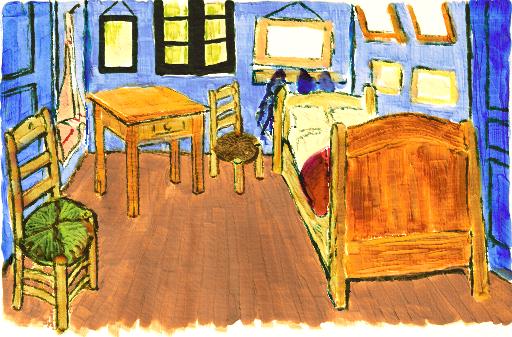

A painting hand-made using IMPaSTo, after a painting by Van Gogh.
Abstract:We present a paint model for use in interactive painting systems that captures a wide range of styles similar to oils or acrylics. The model includes both a numerical simulation to recreate the physical flow of paint and an optical model to mimic paint appearance. Our physical model for paint is based on a conservative advection scheme that simulates the basic dynamics of paint, augmented with heuristics that model the remaining key properties needed for painting. We allow one active wet layer, and an unlimited number of dry layers, with each layer being represented as a height-field. We represent paintings in terms of paint pigments rather than RGB colors, allowing us to relight paintings under any full spectrum illuminant. We also incorporate an interactive implementation of the Kubelka-Munk diffuse reflectance mode, and use a novel eight-component color space for greater color accuracy. We have integrated our paint model into a prototype painting system, with both our physical simulation and rendering algorithms running as fragment programs on the graphics hardware. The system demonstrates the model's effectiveness in rendering a variety of painting styles from semi-transparent glazes, to scumbling, to thick impasto. Contributors:Publication:IMPaSTo: A realistic, interactive model for paint
Full Citation:William V. Baxter, Jeremy Wendt, and Ming C. Lin, "IMPaSTo: A realistic, interactive model for paint." In Stephen N. Spencer (ed.), Proceedings of the 3rd International Symposium on Non-Photorealistic Animation and Rendering, Annecy, France, June 5-7, 2004. (BibTeX) Errata:Equations 8 and 9 are incorrect. The tanh in equation 8 should be coth, and the sinh in equation 9 should be 1 / sinh or csch. Demonstrations:Video (AVI, 30.4 MB) Each of these images was created by a different artist using the IMPaSTo system. A special thanks is deserved by all of our artists for their time, their useful feedback, and most of all their creativity:
News:
Links and Related Work: |